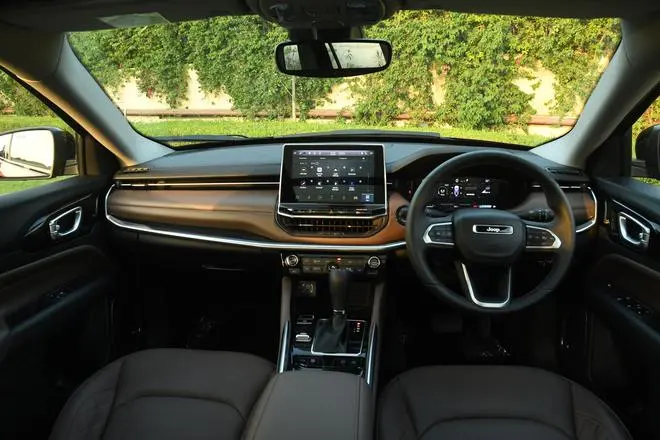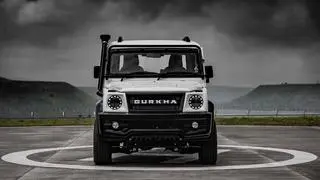The SUV for the extended family has become a staple in many brands’ portfolios. The 3-row, 6-7 seater SUV now has such a lot of demand, that many car makers are unable to make enough, and long waiting periods are common. The news that Jeep is entering this category and that the 3-row version of the Compass will make it to market under an India-exclusive name has been in the news. And yet, it is only when I stand next to the Meridian (known as the Commander in markets like Brazil), that its size and heft really hits me.

The Meridian is huge when you view it from the side. The length almost seems a bit unwieldy, making me wonder if it will be as capable off-road as the Compass. The rear overhang is pronounced and quite a jump over the 2-row Compass. However, the approach, breakover and departure angles have apparently been carefully calibrated with an eye on endowing it with the same legendary prowess of a Jeep. The Meridian is built with the same genetic material as all Jeeps are, but this one is meant for transporting the great Indian joint family. So, how does it fare? I travelled to Chandigarh last month to get behind the wheel of the Meridian. And i can tell you this much that these photos don’t do justice to what one can do with this mammoth 3-row SUV.

Jeep Meridian. Photo : Bijoy Ghosh | Photo Credit: Bijoy Ghosh
Design and build
Though its other dimensions don’t seem to have increased (except for the added length), the Meridian has actually grown in proportions all around. The overall length is more than a foot more than the Compass, and the wheelbase is also up nearly half a foot. The Meridian’s height and width have also increased by a few inches when compared to the Compass. The rear overhang is more than the Compass, but it is not too disproportionate. The Meridian gets a stonking stance due to its elongated wheelbase and taller dimensions. The squared-off wheel arches borrowed from the Compass and the added drama of the rear window (instead of the quarter glass in the 2-row Compass) gives the Meridian context in the Jeep line-up.

Jeep Meridian. Photo : Bijoy Ghosh | Photo Credit: Bijoy Ghosh
Also highlighting the Meridian’s elevated position in the hierarchy are some of the chrome elements that it gets, particularly at the front. The trademark 7-slot bonnet grille gets chrome detailing at the top and bottom, and the front fender gets a thick chrome band that cuts into the fog lamp housing. The 4X4 trim variant that I test drove also featured chrome highlighting for the lip of the underbody protector. Chrome trim for the top of the window line running into the D-pillar is another neat addition that catches the eye since my test mule featured the contrast black roof finish. The 18-inch dual-tone alloys look special and sport a snow-flake design. The rear design is more unique to the Meridian with its slim tail-lamps, the thick chrome garnish that connects the two and the reworked rear fender. It also gets a powered tailgate that can be controlled from inside the cabin, and at the tailgate itself.

Jeep Meridian. Photo : Bijoy Ghosh | Photo Credit: Bijoy Ghosh
Cabin
Quite a few body panels have had to be changed in the Meridian; so, it is not just a Compass that’s been lengthened with that bit of extra space slapped on to the rear. The increased length is evident inside the cabin, too, with that third row of twin seats catching my eye. It is and therein also are the biggest changes in the Meridian’s cabin.

The dashboard has nearly been completely carried over from the Compass. The new 2021 model Compass already featured a significant upgrade and all of those have been brought into the Meridian. The centre console sports a few changes, as do the slimmer door panels. The cabin colour theme is different with the warm brown and black combination elevating the premiumness of the interior. The stitched leatherette finish to the dashboard panels and the metallic accents and details that highlight the panels also help add to the perceived quality of the cabin. The digital instrument cluster and the 10-inch infotainment system are borrowed from the Compass and display nearly the same updated menu options and control buttons. Connectivity is good with wireless Apple CarPlay and Android Auto being available. Some of the other features include a 360-degree camera with parkview display, a dual-pane panoramic sunroof, wireless phone charging and 3-zone air-conditioning with a dedicated blower and evaporator for the third row of seats.

Jeep Meridian. Photo : Bijoy Ghosh | Photo Credit: Bijoy Ghosh
The seats themselves sport a different stitching pattern for the ‘McKinley’ perforated leather upholstery. Even in the Compass, the seats were very comfortable, and they continue to be so in the Meridian. The highlight of the cabin is the third row of twin seats, but the second row is likely to be used more often. In the Meridian, while the second row seems to have been raised just a bit over the Compass, the bench row seats (7-seater configuration) can’t still be moved fore or aft to get more space. The backrest can be reclined and there is one-touch fold and tumble for allowing easy access to the third row. Together with the wide opening doors, entry and exit is relatively easy, though the raised floor and comparable low roof can make it a bit of a squeeze for adults. The floor-mounted third row’s available legroom would also make it more suitable only for kids. Boot space in the new Meridian is quite low with the third row in use. Fold the two seats down and the space available for luggage goes up from about two small suitcases or soft bags to about 480 litres of usable area. The Meridian is being offered in two trim variants - Limited and Limited (O), and with three powertrain options for the Diesel engine.

Jeep Meridian. Photo : Bijoy Ghosh | Photo Credit: Bijoy Ghosh
Performance
The Jeep Meridian is being offered only with one engine option; and it is a diesel. While other 3-row SUVs lower down in the size and price segments offer petrol engines, the Meridian’s size and weight does make the diesel’s torque delivery at lower rpm-levels and better usability at slower speeds the right choice. Yet, it will miss a petrol engine; the Compass’s 1.4-litre turbo petrol might not have been enough for the Meridian. So, what the new 3-row Jeep gets is the same 2-litre multijet II turbocharged diesel mill from the Compass and in the same state of tune. The engine delivers the same 170hp of peak power and 350Nm of peak torque. The powertrain choices include the 6-speed manual or the 9-speed automatic transmissions for the 4X2 version, and the top-trim Meridian Limited 4X4 (four-wheel drive) variant can be had with only the automatic transmission.

The auto transmission 4X2 Meridian was the one I drove on the highway leading up to the off-road driving section that had been curated by Jeep engineers and officials. At the hour-long intense off-road section, I swapped into the 4X4 Meridian Limited. The 9-speed auto gearbox’s calibration and mapping has been tweaked to deliver a more measured performance. The same powertrain in the Compass feels a tad quicker. Engine noise levels are better contained in the cabin at higher rpm-levels. There isn’t much change between the Compass and the Meridian in slow, city speed characteristics. On the highway, the Meridian feels even more composed and steady with the longer wheelbase contributing to the poise. The extra 100+kg weight doesn’t bog down the Meridian’s on-road performance. Behind the wheel I didn’t feel the impact of its size and footprint either. The Meridian truly comes into its own when it steps out of tarmac.
The off-road course was a mix of kutcha trails in wooded terrain, steep rocky climbs, a simulated river bed and some wheel articulation ruts that had been cut into the ground. I do approach the trails with the sense that the Meridian should be fine. But seeing it hustle up and down the rocky, slippery slopes and perform the crazy tilted up wheel articulation sections is still surprising. In fact, I did some of the slippery sections in 4X2 mode and others without even choosing specific settings. There are four off-road settings to choose from, including an auto ‘Selec-Terrain’. The others are snow, sand and mud. It also gets the full suite of off-road aids like hill descent control, which was also offered with the Compass. Handling characteristics on and off the road is brilliant with independent suspension endowed with hydraulic rebound stopper and frequency selective damping. Together they contribute to a ride that is firm yet comfortable.

Jeep Meridian. Photo : Bijoy Ghosh | Photo Credit: Bijoy Ghosh
Bottom Line
The Jeep Meridian is in the same size league as the Mahindra XUV 700, Toyota Fortuner, MG Gloster, Ford Endeavour and the VW Tiguan AllSpace. In terms of its off-road prowess, it shares the same incredible Jeep DNA and that was amply clear from the experience I had up in the hills surrounding Chandigarh. The Meridian does add to Jeep’s portfolio of vehicles that are India-focused and accessible to a larger audience. But it is difficult to gauge how many potential Compass customers may want the extra row of seats. It is entirely possible that many of them might appreciate and want the extra storage space in the Meridian’s boot. And while most, if not all, Jeep customers will barely use the legendary 4X4 abilities of the Meridian, it does help to know that it can conquer the unexplored and, if necessary, also ford that flooded street in the neighbourhood.

Compared to some of the other 3-row SUVs, the Meridian misses out on ADAS (advanced driver assistance systems) features like lane departure warning, adaptive cruise control, etc (regular cruise control is offered). It also doesn’t offer a significant upgrade inside the cabin over the Compass. So, the real USP is only the third row and that can be a good enough reason to choose the Meridian. “After all, a family that sits together, sticks together.”
I expect prices to range from ₹30 lakh to ₹35 lakh.







Comments
Comments have to be in English, and in full sentences. They cannot be abusive or personal. Please abide by our community guidelines for posting your comments.
We have migrated to a new commenting platform. If you are already a registered user of TheHindu Businessline and logged in, you may continue to engage with our articles. If you do not have an account please register and login to post comments. Users can access their older comments by logging into their accounts on Vuukle.